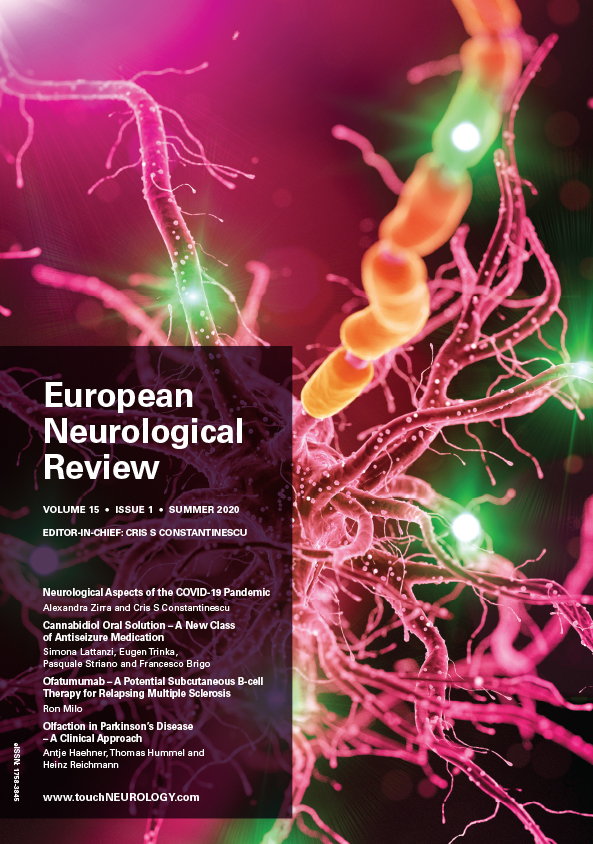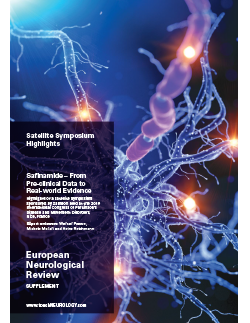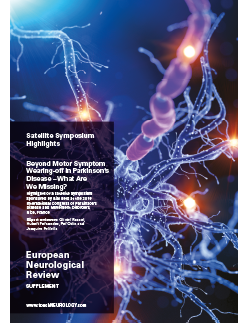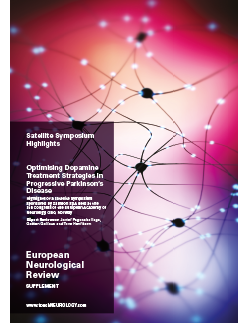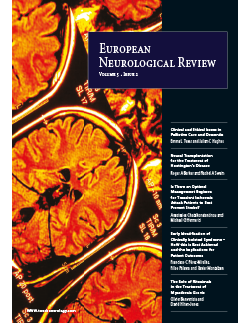
EUROPEAN NEUROLOGICAL REVIEW – VOLUME 5 ISSUE 2 – WINTER 2010
Foreword
Neurology has moved from being an elitist speciality to a broad speciality based in emergency medicine as well as in public health. This edition of European Neurological Review includes important information about stroke and dementia in addition to several central issues in neurology.
Current Issues
Knowledge on the genetic background of a number of neurological disorders has tremendously increased in the last years. The European Federation of Neurological Societies (EFNS) published guidelines for genetic testing in clinical practice in 2001 in two successive papers.1,2 A new EFNS task force has now revised the guidelines about genetic testing in the major […]
Foot drop is the inability to voluntarily dorsiflex the ankle and thereby lift the foot during the swing phase of gait. Foot drop is characterised by dragging the foot, which causes tripping or a steppage gait where the person raises their knee high during swing phase to avoid tripping over the hanging down foot and […]
Neurodegenerative Disease
The term ‘dementia’ is used to describe a decline in intelligence, memory and judgement as a result of brain disorders. The following cognitive deficits are common in dementia: impaired judgement (decline in intellectual performance and critical thinking), deficits in logical thinking and deductive reasoning, inability to understand or process information, memory deficits and loss of […]
Since the prevalence of dementia is increasing as the population ages, estimates of the number of people with dementia are constantly being adjusted; the current estimate is that 7–8 million people in Europe have got dementia.1 In 2010, the number of people in the world affected by dementia is estimated to be 35.6 million.2 People […]
Since its introduction in the 1960s, dopamine replacement therapy with its metabolic precursor L-3,4-dihydroxyphenylanaline (L-DOPA) has remained the most effective pharmacotherapy for Parkinson’s disease (PD).1 Particularly in early disease, it is efficiently converted into dopamine, replacing that which is lost through the degeneration of nigrostriatal dopaminergic neurons. In doing so, L-DOPA alleviates bradykinesia and rigidity, […]
Huntington’s disease (HD) is a progressive neurodegenerative disorder that is inherited and characterised by involuntary movements, psychiatric and cognitive symptoms and signs. It is caused by an expansion of the CAG repeat in exon 1 of the huntingtin gene. Patients with 36 or more CAG repeats in this gene develop HD; this abnormal expansion results […]
Huntington’s Disease Huntington’s disease (HD) is an autosomal-dominantly inherited neurodegenerative disorder. It has a prevalence of 5–7 per 100,000 people in European and North American populations.1 The first symptoms typically appear between the ages of 35 and 45 years and include minor uncontrollable movements and personality changes such as depression and irritability.1
Huntington’s disease (HD) is a monogenetic disorder with a spectrum of clinical features. Besides the characteristic involuntary motor disturbances, such as chorea, individuals affected by the disease suffer from psychiatric symptoms and cognitive decline.1–3 Despite this, focus on the movement disorder in clinical practice and the research of HD has been strong.
Neuroimaging opens the possibility of non-invasive investigation of structural and dynamic processes in the human brain in vivo. It is a helpful tool to explore the impact of structural and functional changes at the cortical and subcortical level in different neurological and psychiatric pathologies. Magnetic resonance imaging (MRI) with its various applications is one of […]
Brain Trauma
The classic definition of transient ischaemic attacks (TIAs), based on focal neurological deficits most likely due to cerebrovascular diseases with full recovery within 24 hours, dates back to the 1960s.1 With the advent of advanced neuroimaging techniques (computed tomography [CT] and magnetic resonance imaging [MRI]), new insights into pathobiology and prognosis of cerebrovascular events, as […]
Stroke induces acute deficits of motion, sensation, cognition, emotion and communication that may occur in isolation or in various combinations depending on the location and size of the infarct lesion. Stroke lesions develop dynamically from the initial lesion corresponding to the area of restricted water diffusion (cytotoxic oedema), which enlarges in most cases into the […]
Paraneoplastic neurological syndromes (PNS) were first described in the 20th century. A summary of observations dating back to 1982 was published in the seminal book by Henson and Urich.1 The detection of autoantibodies for myasthenia gravis (MG) and later for Lambert-Eaton myasthenic syndrome (LEMS), marked a new era of antibody-mediated disease. Several onconeural antibodies were […]
Multiple Sclerosis
Many of the disease-modifying therapies (DMTs) that are available for the treatment of multiple sclerosis (MS) require frequent administration by subcutaneous or intramuscular injections. Current first-line therapies include interferon beta-1a (INFβ-1a), INFβ-1b and glatiramer acetate. INFβ-1a is available as two formulations: Avonex® is administered as a once-weekly intramuscular injection and Rebif® is injected subcutaneously (SC) […]
The introduction of disease-modifying drugs (DMDs) during the 1990s made chronic therapies that inhibit the disease process in multiple sclerosis (MS) available to patients for the first time.1,2 While the currently available DMDs decrease the number of relapses, delay the onset of disabilities, improve quality of life (QoL) and allow increased participation in work and […]
Multiple sclerosis (MS) is a chronic disease of the central nervous system (CNS) that mainly affects young adults and is characterised by an inflammatory demyelination of different areas of the CNS occurring at different time points. MS has several forms of presentation, including episodic subacute periods of worsening (the most common, initially), gradual progressive deterioration […]
Neuromuscular Disease
Myasthenia gravis (MG) is an autoimmune disease associated with circulating antibodies, either against the nicotinic acetylcholine receptor (anti-AChR; ~80% of patients with generalised MG) or muscle-specific tyrosine kinase (anti-MuSK, 10% of patients),1 that induce a dysfunction of neuromuscular transmission owing to loss of functional receptors. Less commonly, MG remains confined to the ocular muscles. Only […]

Trending Topic
Chronic inflammatory demyelinating polyradiculoneuropathy (CIDP) is a rare, autoimmune neurological disorder in which peripheral nerve demyelination typically results in weakness, impaired limb sensation, fatigue and pain.1–4 CIDP may adversely affect activities of daily living, with a substantial impact on functional ability and psychological well-being.2–6 Primary treatment goals are reducing symptoms, improving functional status and maintaining long-term remission.7 The […]
Journal Archive
European Neurological Review is a peer-reviewed, free-to-access, bi-annual neurology journal comprising review articles, case reports, practice guides, theoretical discussions, and original research. It features balanced and comprehensive articles written by leading authorities, addressing the most important and salient developments in the field of neurology in practical terms.
Latest articles videos and clinical updates - straight to your inbox
Log into your Touch Account
Earn and track your CME credits on the go, save articles for later, and follow the latest congress coverage.
Register now for FREE Access
Register for free to hear about the latest expert-led education, peer-reviewed articles, conference highlights, and innovative CME activities.
Sign up with an Email
Or use a Social Account.
This Functionality is for
Members Only
Explore the latest in medical education and stay current in your field. Create a free account to track your learning.


